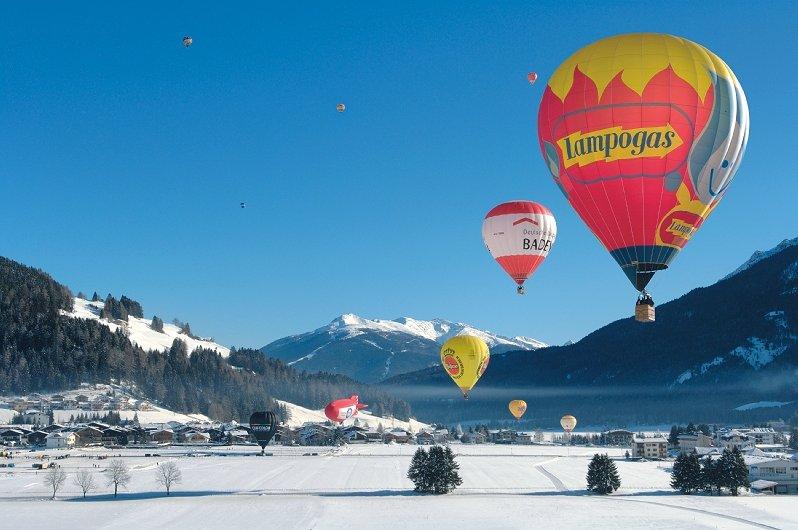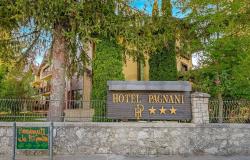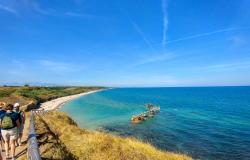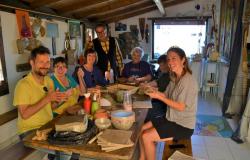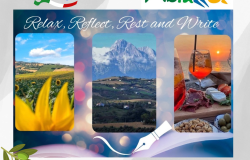John Bensalhia kicks off the new year by looking at a selection of some of the most memorable events and festivals to warm up Italy in January.
With Christmas and New Year's Eve done and dusted, there's still plenty to celebrate once the new year makes its mark. January is a time for colourful, enjoyable festivities, encompassing the traditional, sporty and scenic. It's little wonder that visitors from across the globe want to be part of Italian festivities this month – read on...
EPIPHANY - 6th January
Traditionally, the 6th January is just as important in Italy as the 25th December. The day of Epiphany marks a national holiday throughout Italy, and is celebrated in a number of ways.
For the youngsters, they can wait to see if their stockings are brimming with gifts or lumps of coal. La Befana is said to determine this after visiting the young ones in the night with only a broomstick and a sack full of presents for company. La Befana can be traced back to the original story of the Nativity. Legend has it that the Three Wise Men went to an old woman to ask about directions to their destination. While initially declining the invitation to join them, La Befana is said to have ultimately changed her mind, but when she went looking she couldn't find her way. So the story goes that La Befana flies around on her broomstick to this day, still searching for her destination.
La Befana even has her own special events held in her honour. These include a four-day festival in Urbania (Le Marche) where kids can meet the witch in her abode. There are also special races held in her honour in locations such as Venice, including Regatta delle Bafane.
A common practice in Italy is to repeat the living nativity event which was initially held between 24th and 26th December. One of the most impressive examples is the Custonaci Epiphany Nativity Play which is held in Scurati Cave on 6th January. Scurati Cave provides a unique backdrop for the traditional tale and lends the event an atmosphere and magic all of its own.
Vatican City sees a procession make its way through the avenue to the Vatican itself. People come bearing symbolic gifts for the Pope, and are dressed in medieval outfits. Following the procession, the Pope says morning mass in St Peter's Basilica to mark the visitation of the Three Wise Men to Baby Jesus.
Other notable parades and processions include Florence's Calvacata dei Magi, which goes from Pitti Palace to Duomo. It's a historical procession that also includes a flag performance in Piazza della Signoria. In Milan, the Epiphany Parade of the Three Kings provides a memorable event as it leads to the Church of Sant'Eustorgio. Meanwhile, in Rivisondoli, Abruzzo, a special re-enactment of the arrival of the Three Kings is played out with much colour and style.
DOLOMITI BALLOON FESTIVAL - 8th - 18th January
The 5th Dimension once crooned about the virtues of going up up and away in a beautiful balloon in 1967. Well, that opportunity is now available to those who visit the Dolomiti Balloon Festival which is held in Dobbiaco.
Visitors at the Dolomiti Balloon Festival can get the chance to see the beautiful scenery of the Dolomites from the warmth and comfort of a hot air balloon. It's a unique and breathtaking experience which will be guaranteed to stick in the memory forever.
The many balloons on display include the standard hot air balloons as well as the fun, decorative examples – past examples have included faces of ducks and elephants and even Tony The Tiger. There are also model balloons and the greatest example gets to win a special prize in one of the competitions held at this event.
WSF WORLD ROOKIE FEST - 10th - 15th January
The World Snowboard Federation presents the World Rookie Fest which is held in Livigno between the 10th and 15th January.
This is a snowboard freestyle contest for young competitors from across the globe. Gathering at Mottolino Fun Mountain, the contestants will aim to be the best in the snowboarding field.
The International Slopestyle Event is held at the Mottolino Snowpark which will see female and male competitors compete to be the best. There is also a contest held for the under-15s who will have enjoyed a three-day camp to teach them the art of this popular sport.
FEAST OF SANT'ANTONIO ABATE - 17th January
St. Anthony is known for being many things. An abbot. The patron saint of domestic animals and basketmakers. He is also said to offer protection against skin diseases.
During his lifetime, St. Anthony lived the quiet life of a hermit, using the power of prayer to ward off any potential temptation by the devil.
To mark the life of St. Anthony the Abbot on 17th January, a number of events and celebrations are held throughout Italy. Music is played, processions are led and bonfires are lit. In the case of the latter example, bonfires represent the legend that St. Anthony stole the devil's fire from Hell. Areas such as Novoli, Caserta, Abruzzo and Sardinia celebrate with lots of music, dancing and parades. It's also traditional for the first Sunday after the 17th to hold Il Palio di Sant'Antonio Abate in Buti, near Pisa. The neighbourhoods enter this horse racing competition complete with accompanying procession and the traditional colours of the area.
ST. SEBASTIAN FEAST DAY - 20th January
St. Sebastian was a Christian saint and a martyr who, according to legend, endured some terrible agonies. During the reign of Roman Emperor Diocletian at the height of the persecution of Christians, it is said that St. Sebastian was shot with arrows while being tied (either to a tree or post). While the legend continues that he was rescued and healed by Irene of Rome, St. Sebastian ultimately met his doom after confronting the Emperor in person to criticise his actions. As a result, St. Sebastian was clubbed to death.
So on the 20th January, this Christian martyr and saint is honoured. Parades, services and events are held in St Sebastian's name. Acireale, for example, holds a parade that is brimming with colour and spectacle. Mistretta leads a large statue of the saint through the town (with 60 men carrying the icon). In Abruzzo, the city of Ortona lights a papier mache model of a specially decorated boat known as the Vaporetto. It's the scene for a spectacular fireworks display outside the Cathedral and makes for one of many fitting celebrations of St. Sebastian.
WINTER MARATHON OF MADONNA DI CAMPIGLIO – 22nd - 25th January
The latest state-of-the-art cars whizz by in the 21st century. Sleek, fast and powerful, they invite the envy of anyone who casts a casual glance.
But on the other hand, any car aficionado will still have a hankering for the classic car. There's something about the older style car that conjures up a sense of class and quirky charm all of its own. Fans of the good old days of the motor car can enjoy a superb spectacle at the Winter Marathon of Madonna Di Campiglio which takes place between the 22nd and 25th January.
The event is massively popular and is now in its 27th year. The historic car rally chiefly comprises a line-up of cars built prior to 1968, but there is also a selection of collectable, historically significant motors which were 'built up to 1976.
Trophies awarded during this rally include the Trophy MA-FRA (which is the prize for the pre-war sports cars entered in the Marathon) and the TAG Heuer Barozzi Trophy. It's four days of vintage motor heaven for car fans and is an event not to be missed.
LA FIERA DI SANT'ORSO (FAIR OF SANT'ORSO) - 30th - 31st January
If it's tradition you're seeking in January, then this 800 year old event in Aosta could be right up your street.
The Fair of Sant'Orso sells a wide range of arts and crafts made from materials such as stone, wood and metal. It is said that the Sant'Orso church distributed clothes and traditional wooden shoes called sabots to the poor in the Middle Ages.
Today, the event continues and is extremely popular – it's a fair that combines the finest in traditional craftsmanship, folklore and the beautiful environment of Aosta. The fair is held in the city centre and the area around the Roman city wall. The stalls are brimming with the likes of decorations for the house and garden, cutlery, furniture, sculptures, goodies for animals and of course, sabots. In addition to the stalls, there is plenty of food to enjoy, plus mulled wine to keep you warm! Traditional Alpine music caps off the event in the background, which still pulls in large crowds 800 years on.
VENICE CARNIVAL - 31st January - 17th February
It's regarded as “The party most delicious in the world” and is one of Italy's key events that has the power to attract visitors from all around the world.
The Venice Carnival, a regular occurrence in the calendar since 1979, is set to bloom again from the 31st January and will again provide colour, spectacle and enjoyment in abundance. Prior to this, the Venice Carnival can be traced back to 1162 when victory of the Serenissima Repubblica against the Patriarch of Aquileia, Ulrico di Treven was celebrated.
Following this victory, the carnival became an official event in the era of the Renaissance and continued during the Baroque age and then reaching a peak of popularity in the 18th century. But this popularity was to be cut short. During the reign of the King of Austria, the event was banned – only to resurface sporadically in the following century. By 1979, the event was revitalised and continues to be a hugely popular festival.
Part of the appeal is the wide range of decorative, distinctive and elegant masks. The masks are a key part of the carnival, including creations such as the popular Volto, the disquieting Bauta and the bespectacled look of Medico della peste (Plague Doctor). There is an annual competition to find the best mask as fashion designers and costumers meet to judge the winner.
